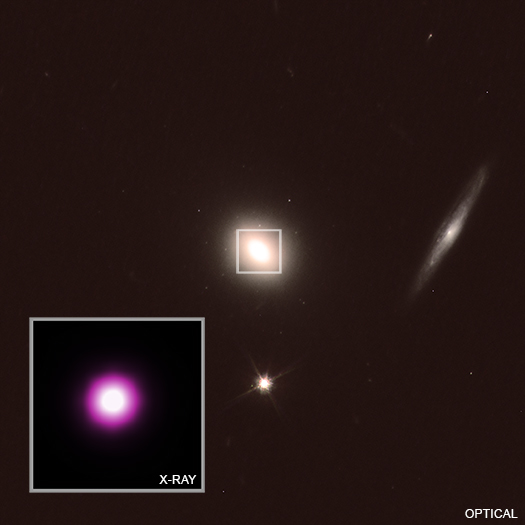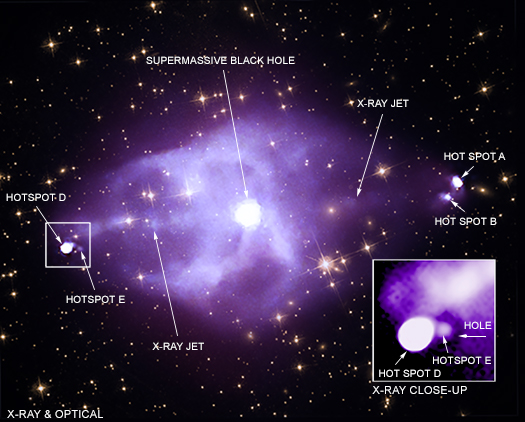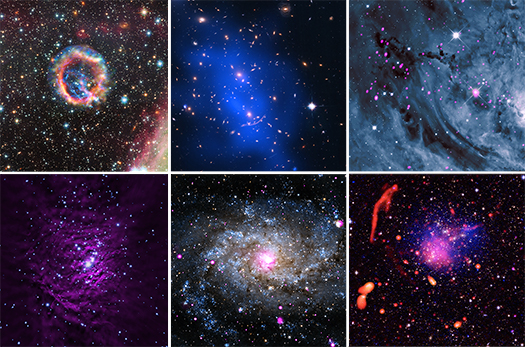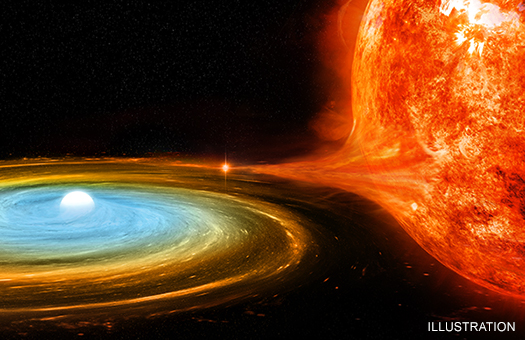The Whirlpool Galaxy Like You’ve Never Seen It Before
NASA's Universe of Learning, or UoL, provides resources and experiences that enable youth, families, and lifelong learners to explore fundamental questions in science, experience how science is done, and discover the Universe for themselves.
To make this goal a reality, this consortium of professional scientists, educators, visualizers, and more work together to create resources for anyone interested in learning about our Universe. The latest product from the UoL is a new visualization of Messier 51, also known as the Whirlpool galaxy. Located about 30 million light years from Earth, the Whirlpool galaxy is a spiral like our own Milky Way.
The Whirlpool Galaxy, M51
Credit: X-ray: NASA/CXC/Wesleyan Univ./R.Kilgard, et al; Optical: NASA/STScI
Chandra to Continue Operations During US Government Shutdown

NASA has designated Chandra as "excepted" during the Government shutdown and requested that SAO continue Chandra X-ray Center (CXC) operations. Since NASA is unable to provide funding during the shutdown, the Smithsonian Institution has agreed to advance funding to continue science and mission operations through mid-March, as necessary.
Shredded Star Leads to Important Black Hole Discovery
This artist's illustration shows the region around a supermassive black hole after a star wandered too close and was ripped apart by extreme gravitational forces. Some of the remains of the star are pulled into an X-ray-bright disk where they circle the black hole before passing over the "event horizon," the boundary beyond which nothing, including light, can escape. The elongated spot depicts a bright region in the disk, which causes a regular variation in the X-ray brightness of the source, allowing the spin rate of the black hole to be estimated. The curved region in the upper left shows where light from the other side of the disk has been curved over the top of the black hole.
This event was first detected by a network of optical telescopes called the All-Sky Automated Survey for Supernovae (ASASSN) in November 2014. Astronomers dubbed the new source ASASSN14-li and traced the bright flash of light to a galaxy about 290 million light years from Earth. They also identified it as a "tidal disruption" event, where one cosmic object is shredded by another through gravity.
Cygnus A: Ricocheting Black Hole Jet Discovered by Chandra
A ricocheting jet blasting from a giant black hole has been captured by NASA's Chandra X-ray Observatory, as reported in our latest press release. In this composite image of Cygnus A, X-rays from Chandra (red, green, and blue that represent low, medium and high energy X-rays) are combined with an optical view from the Hubble Space Telescope of the galaxies and stars in the same field of view. Chandra's data reveal the presence of powerful jets of particles and electromagnetic energy that have shot out from the black hole. The jet on the left has slammed into a wall of hot gas, then ricocheted to punch a hole in a cloud of energetic particles, before it collides with another part of the gas wall.
Studying Comet 46P/Wirtanen During its Close-by Visit Near Earth

Dennis Bodewits in Japan during the
‘Comets, Meteors, and Asteroids’ conference.
We welcome Dennis Bodewits as a guest blogger. Dennis studies the chemical and physical behavior of comets. He is an associate professor at Auburn University in Auburn, Alabama, and leads a large observing campaign combining multiple NASA spacecraft to study comet 46P/Wirtanen during its close-by visit near Earth. He loves the outdoors, mountain biking in Auburn's Chewacla State Park, and has piloted a human-powered helicopter.
I got into comet research while conducting experiments at the University of Groningen in the Netherlands. My work supported fusion — where two lighter nuclei join to create heavier ones — research. To measure the temperature in fusion plasmas, you can't just stick a thermometer in your reactor. Instead, the idea was to let in a little bit of trace gas which would make the ions, that is, atoms that have a positive charge, glow.
It turned out that the main reaction responsible for this light, charge exchange, had been discovered in comets. Charge exchange is the process where a charged ion collides with a neutral atom or molecule and captures one of its electrons. Light is then emitted as the captured electron moves to a lower energy state. This process is especially important in comets where ions from the solar wind collide with neutral atoms in cometary atmospheres. For my doctorate I worked on trying to find out what I could learn about comets and the solar wind from charge exchange emission, combining lab work with Chandra observations.
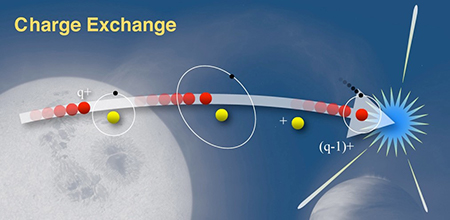
Chandra Serves up Cosmic Holiday Assortment
This is the season of celebrating, and the Chandra X-ray Center has prepared a platter of cosmic treats from NASA's Chandra X-ray Observatory to enjoy. This selection represents different types of objects — ranging from relatively nearby exploded stars to extremely distant and massive clusters of galaxies — that emit X-rays detected by Chandra. Each image in this collection blends Chandra data with other telescopes, creating a colorful medley of light from our Universe.
A Hero of the Heroic Age of Astronomy
Riccardo Giacconi (1931-2018)
Riccardo Giacconi, the "Father of X-ray Astronomy," Nobel prize-winner, and one of the most influential figures of modern astrophysics, has died at the age of 87.
Giacconi was born in Genoa Italy on October 6, 1931. He spent most of his life until 1956 in Milan, where he obtained a Ph.D. in physics from the University of Milan, working under the direction of noted cosmic ray physicist Giuseppe Ochialini. Giacconi subsequently worked as an assistant professor at the University of Milan before emigrating to the United States to work for R.W. Thompson as a Fulbright Fellow at Indiana University.
From Indiana he moved to Princeton where he met and worked with Herbert Gursky, also a post-doctoral fellow. According to Giacconi, "We built equipment, worked like fiends, analyzed data, and declared failure." When his Fulbright fellowship expired, Giacconi moved to American Science and Engineering (AS&E) in Cambridge, MA, a startup formed by Martin Annis, an ex-student of Bruno Rossi of the Massachusetts Institute of Technology (MIT). At that time AS&E was primarily involved in military space research.
Remembering Riccardo Giacconi, X-Ray Astronomy Pioneer
Courtesy of NASA.gov

Riccardo Giacconi (Credit: R.K. Morris)
NASA is saddened to note the passing of Riccardo Giacconi, who had a long and illustrious career with the agency.
“Riccardo set the standard for the way that NASA astrophysics is done, by involving the entire astronomy community in space missions via robust Guest Observer programs. We continue to benefit from his foresight,” said Paul Hertz, Director of Astrophysics at NASA.
Giacconi’s early sounding rocket work opened the field of X-ray astronomy, in which NASA continues to be a world leader. He led the sounding rocket experiment that discovered the first two non-solar cosmic X-ray sources: the X-ray background and the neutron star Scorpius X-1. This breakthrough led Giacconi to propose to NASA the Small Astronomy Satellite-A or SAS-A, renamed “Uhuru” at launch. The satellite produced the first catalog of cosmic X-ray sources.
He went on to develop the first focusing X-ray telescope, the Einstein Observatory, and then to write the proposal for NASA's Chandra X-ray Observatory. Chandra continues to operate today, and is the most sensitive X-ray observatory ever developed.
Cosmic Fountain Powered by Giant Black Hole
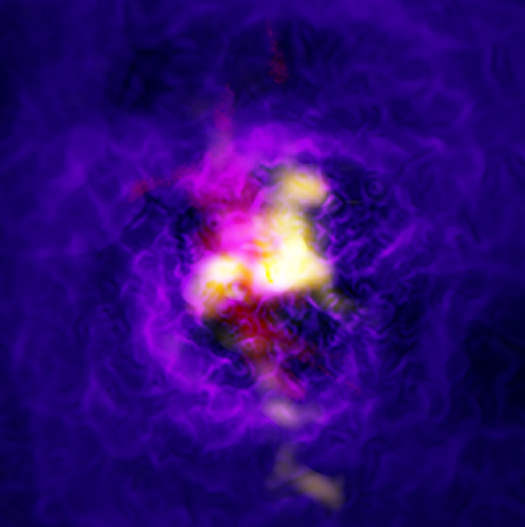
Abell 2597
Credit: X-ray: NASA/CXC/SAO/G. Tremblay et al; Radio:ALMA: ESO/NAOJ/NRAO/G.Tremblay et al, NRAO/AUI/NSF/B.Saxton; Optical: ESO/VLT
Before electrical power became available, water fountains worked by relying on gravity to channel water from a higher elevation to a lower one. This water could then be redirected to shoot out of the fountain and create a centerpiece for people to admire.
In space, awesome gaseous fountains have been discovered in the centers of galaxy clusters. One such fountain is in the cluster Abell 2597. There, vast amounts of gas fall toward a supermassive black hole, where a combination of gravitational and electromagnetic forces sprays most of the gas away from the black hole in an ongoing cycle lasting tens of millions of years.
Scientists used data from the Atacama Large Millimeter/submillimeter Array (ALMA), the Multi-Unit Spectroscopic Explorer (MUSE) on ESO's Very Large Telescope (VLT) and NASA's Chandra X-ray Observatory to find the first clear evidence for the simultaneous inward and outward flow of gas being driven by a supermassive black hole.



